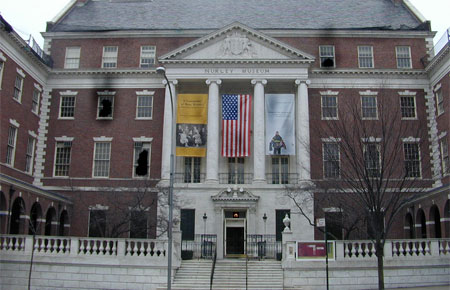The Nurley Museum: Difference between revisions
AndyMatthews (talk | contribs) No edit summary |
|||
| Line 1: | Line 1: | ||
{{User:DangerReport/ | {{User:DangerReport/{{PAGENAME}}}} | ||
{{Locationblock| | {{Locationblock| | ||
suburb=Dulston| | suburb=Dulston| | ||
Revision as of 04:04, 9 October 2024
| The Nurley Museum EHB, dark. AndyMatthews (talk) 06:18, 15 October 2024 (UTC)
|
| the Nurley Museum
Dulston [90,6]
Basic Info:
|
You are inside the Nurley Museum, currently displaying a collection of African sculpture.
Building Status
The Nurley Museum is an African Sculpture museum located in the suburb of Dulston on the border with Rhodenbank. The building is known to be the only remaining building from the 1919 National Science Exposition, the former Fine Arts Building. The other buildings were all torn down over the intervening years. The building, which was constructed of longer-lasting materials than the other Exposition buildings, initially housed the Field Museum of Natural History. When a new Field Museum building opened downtown in 1940, the former site was left vacant. After a few years, the building was selected as the site for a new science museum. The building's exterior was re-cast in stone, retaining its early-1900s Beaux Arts look, while the interior was completely rebuilt in Art Deco style.
The museum was truly established in 1956 by wealthy MaltCo chairman Harold S. Nurley, who pledged $7 million to the institution. He eventually donated over $15 million when assurances were made that he could direct how the funds were spent. Even so, out of modesty he requested that his name not appear on the building, but the Malton city council insisted considering the sizable sum he had donated. After much discussion he finally acquiesced to the honor and the building became known from that point on as the Nurley Museum. With his money firmly invested in the museum's future Nurley made time in his busy schedule to oversee the building's development which he envisioned as an interactive museum similar in the style of the Deutsches Museum, or at least the way the German museum had been before it was seriously damaged by Allied bombing during World War II.
The Nurley Museum conducted a citywide search to find its first director. In the end the board of directors selected Aldric Schwarzkopf because he shared Harold S. Nurley's vision. At the time Schwarzkopf was the science editor for the Eastonwood Daily. Now in his new role as museum director he assembled the museum's first staff and began organizing and constructing the exhibits. He was also considered instrumental in developing close ties with the science departments of the University of Ridleybank which supplied much of the scholarship for the exhibits. Schwarzkopf ended his career on a dark note when he resigned in 1977 amid growing disputes between himself and the board of directors over the objectivity and neutrality of the exhibits.
These days the Nurley Museum has several permanent exhibits. The Take Flight exhibit simulates a city-to-city flight using a real Boeing 727 jet plane donated by United Airlines. The Gold Mine exhibit re-creates a working mine inside one of the museum's hallways. The most recent exhibit to open, prior to the "Malton Incident", is a display for a Focke-Wulf Fw 190 F-8, a German single-engined fighter that was captured by the US forces in World War II. Unfortunately, as is the case with human nature, many of the exhibits have since been vandalized. Not to mention the ruined natural history section which at some point had been set ablaze, with the fire spreading unchecked into the upper floors before the sprinkler system finally managed to quell the inferno.
Barricade Policy
Barricades should be kept at Extremely Heavily at all times. The true purpose of this building is to serve as a heavily fortified shelter for Malton's veteran survivors. This ruling was set forth by the Dulston Optimal Defense Diagram and is enforced by all member groups of the Dulston Alliance.
Current Events
April 28th, 2010 - Meryl Silverburgh reports dispatching one zed shuffling around the entrance of the Nurley Museum with her USP.45, and noted that the building was extremely heavily barricaded before making her bed elsewhere.
December 10th, 2008 - Officer Murphy of Dead vs Blue reported that the museum was now Loosely barricaded.
December 6th, 2008 - Officer Murphy of Dead vs Blue reported that he had repaired and Loosely re-barricaded the museum. Consider the amount of damage the building had taken, he reported, this was the best he could do for the time being.
- Update: The Nurley Museum was reported to have fallen, but as it was never meant to serve as a shelter, Dulston Alliance forces in the immediate area were non-plussed by the attack.
November 25th, 2008 - Almost 2 months have passed since any news was posted here. Not much to say, but to report that the suburb is still reeling from the attack by the Militant Order of Barhah. As such, it's no surprise that the museum is not barricaded.
September 23rd, 2008: Dead vs Blue recon reported that the Nurley Museum was barricaded and in survivor hands for the time being.
November 15th, 2006 - Members of DORIS persist in their claims of controlling all Dulston. Taking a page straight from Conquerors 101 DORIS has instigated a policy whereby local buildings and streets throughout the suburb have been renamed by their group, in this case, the museum is now known as the The Spad Museum as far as DORIS is concerned.
August 21st, 2006 - A member of the Philosophe Knights visited the museum on a fact finding mission in order to catalog the Nurley Museum's collection. After completing their task the survivor moved on to Malton's other museums.
March 4th, 2006 - The Bad, a veteran survivor from Dead vs Blue, was stationed here at the museum for several days in order to maintain an active watch for zombies crossing over from nearby Rhodenbank.

